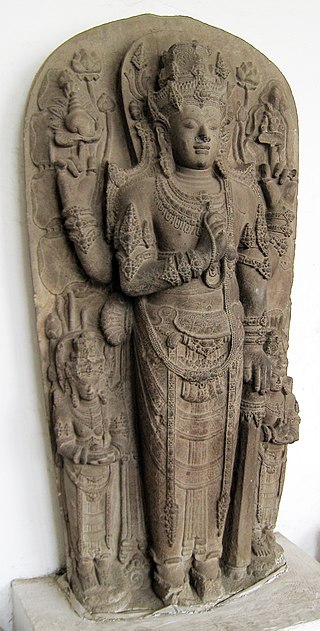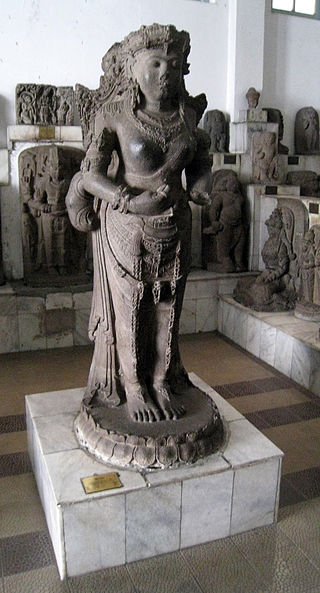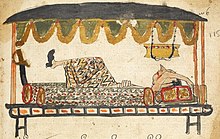
Wayang is a traditional form of puppet theatre play originating from the Indonesian island of Java. Wayang refers to the entire dramatic show. Sometimes the leather puppet itself is referred to as wayang. Performances of wayang puppet theatre are accompanied by a gamelan orchestra in Java, and by gender wayang in Bali. The dramatic stories depict mythologies, such as episodes from the Hindu epics the Ramayana and the Mahabharata, as well as local adaptations of cultural legends. Traditionally, a wayang is played out in a ritualized midnight-to-dawn show by a dalang, an artist and spiritual leader; people watch the show from both sides of the screen.

Gajah Mada, also known as Jirnnodhara, was a powerful military leader and mahapatih of the Javanese empire of Majapahit during the 14th century. He is credited in Old Javanese manuscripts, poems, and inscriptions with bringing the empire to its peak of glory.

Hayam Vuruk (1334–1389), also called Rajasanagara, Pa-ta-na-pa-na-wu, or Bhatara Prabhu after 1350, was a Javanese Hindu emperor from the Rajasa dynasty and the 4th emperor of the Majapahit Empire. Together with his prime minister Gajah Mada, he reigned the empire at the time of its greatest power. During his reign, the Hindu epics, the Ramayana and the Mahabharata, became ingrained in the culture and worldview of the Javanese through the wayang kulit. He was preceded by Tribhuwana Wijayatunggadewi, and succeeded by his son-in-law Wikramawardhana.

The Kingdom of Pajang or Sultanate of Pajang was a short-lived Muslim state in Java. It was established by Adiwijaya or Jaka Tingkir, Lord of Boyolali, after a civil war and was a successor to Sultanate of Demak. Adiwijaya claimed to be a descendant of Brawijaya V, the last king of the Majapahit empire, and Trenggana, the sultan of Demak.

Raden Wijaya or Raden Vijaya was a Javanese emperor, and the founder and first monarch of the Majapahit Empire. The history of his founding of Majapahit was written in several records, including Pararaton and Negarakertagama. His rule was marked by the victory against the army and the Mongol navy of Kublai Khan's Yuan dynasty.

Suhita or Soheeta, was a Javanese queen regnant and the sixth monarch of the Majapahit empire, ruling from 1429 to 1447.

Tribhuwana Wijayatunggadewi, known in her regnal name Tribhuwannottunggadewi Jayawishnuwardhani, also known as Dyah Gitarja or Gitarja, was a Javanese queen regnant and the third Majapahit monarch, reigning from 1328 to 1350. She also bears the title Bhre Kahuripan. With the help of her prime minister Gajah Mada, she pursued a massive expansion of the empire. Tradition mentioned her as a woman of extraordinary valour, wisdom and intelligence.

Trowulan is an archaeological site in Trowulan Subdistrict, Mojokerto Regency, in the Indonesian province of East Java. It includes approximately 100 square kilometres and has been theorized to be the site of the eponymous capital city of the Majapahit Empire, which is described by Mpu Prapanca in the 14th-century poem Nagarakretagama and in a 15th-century Chinese source. When it was the capital of the Majapahit Empire, the city was known as Wilwatikta, which is a name also synonymous with the empire's name. It was razed during the invasion of Girindrawardhana to defeat Kertabhumi in 1478. After this event Majapahit's capital was moved to Daha (Kediri). The Trowulan Museum includes a collection of artifacts.

The Legend of Roro Jonggrang is a Javanese popular legend (folktales) from Central Java telling the story of love and betrayal, the warrior and the cursed princess. It also explains the mythical origin of Ratu Boko palace, Sewu temple, and the Durga statue in Prambanan temple compound. The title Roro is an ancient honorific title to address unmarried princesses and female nobility, thus the name Rara Jonggrang in Javanese means 'slender maiden'.

Sri Aji Kresna Kepakisan was a king of Bali who governed the island under the suzerainty of the Javanese Majapahit Empire. He is supposed to have ruled in the mid-14th century, and to be the ancestor of the later kings of Bali. His historicity is, however, not clearly documented.
Dyah Pitaloka Citraresmi or Citra Rashmi (1340–1357), was the princess of the United Sunda Kingdom and Galuh Kingdom in Western Java. According to the Pararaton or Book of Kings, she was supposed to marry Hayam Wuruk, the new young king of Majapahit who had a great desire to take her as his queen. However, in the tragedy known as The Bubat Incident, she took her own life. Tradition describes her as a young woman of extraordinary beauty.
The Battle of Bubat also known as Pasunda Bubat is the battle between the Sundanese royal family and the Majapahit army that took place in Bubat Square on the northern part of Trowulan in 1279 Saka or 1357 CE.
The Blambangan Kingdom was the last Javanese Hindu kingdom that flourished between the 13th and 18th centuries, based in the eastern corner of Java. The capital was at Banyuwangi. It had a long history of its own, developing contemporaneously with the largest Hindu kingdom in Java, Majapahit (1293–1527). At the time of the collapse of Majapahit in the late fifteenth century, Blambangan stood on its own as the one solitary Hindu state left in Java, controlling the larger part of Java’s Oosthoek.

Kahuripan was an 11th-century Javanese Hindu-Buddhist kingdom with its capital located around the estuarine of Brantas River valley in East Java. The kingdom was short-lived, only spanning the period between 1019 and 1045, and Airlangga was the only raja of the kingdom, which was built out of the rubble of the Kingdom of Mataram after the Srivijaya invasion. Airlangga later in 1045 abdicated in favour of his two sons and divided the kingdom into Janggala and Panjalu (Kadiri). The kingdom's name derived from Old Javanese term hurip with circumfix ka- -an which means "life" or "livelihood". Later in 14th to 15th century, the former kingdom was recognised as one of Majapahit's 12 provinces.
Dara Petak or Dara Pethak, also known in her formal name as Indreswari, was the consort of King Kertarajasa Jayawardhana, the founder of Majapahit kingdom. She was a Dharmasraya princess from Sumatra and the only non-Javanese wife of Kertarajasa, and also the mother of Jayanegara, the second monarch of Majapahit. Tradition mentioned her as a woman of exceptional beauty.
Dara Jingga, was one of the Malay Dharmasraya princess who was intended to be betrothed to Javanese King Kertanegara of Singasari after the Pamalayu expedition 1275–1293.

Raden Patah, also known as Jin Bun was the first sultan of the Demak Sultanate. Ascending to the throne in 1475, he remained a vassal of the Majapahit Empire until 1478. Raden Patah took the title Panembahan Jimbun after legitimizing the Sultanate of Demak as the successor state to the Majapahit Empire, with the Wali Sanga appointing him the Sultan of Demak.
The Regreg War was a civil war that took place in 1404–1406 within the Javanese empire of Majapahit. The conflict was fought as a war of independence between the Western court led by Wikramawardhana against the breakaway Eastern court led by Bhre Wirabhumi. This war of rivalry and secession had caused calamity, crisis, court's preoccupation, the drain of financial resources, and exhaustion, which is thought to be one of the causes of Majapahit's decline in the following years.

The Kingdomship of Bali was a series of Hindu-Buddhist kingdoms that once ruled some parts of the volcanic island of Bali, in Lesser Sunda Islands, Indonesia. With a history of native Balinese kingship spanning from the early 10th to early 20th centuries, Balinese kingdoms demonstrated sophisticated Balinese court culture where native elements of spirit and ancestral reverence combined with Hindu influences—adopted from India through ancient Java intermediary—flourished, enriched and shaped Balinese culture.
Raden Kusen, also known as Kin San was the Duke of Terung and one of the last commanders of the Majapahit Imperial Army. His father was the Duke of Palembang, Arya Damar while his mother was Siu Ban Ci, the former concubine of Majapahit Emperor. He was a half-brother of Raden Patah, the founder of the Demak Sultanate. He supposedly was to succeed his father at the Duchy of Palembang, as the Duke of Palembang, but he along with his brother moved to Java island. His descendants, the sultans of Palembang from the 17th century until 19th century were his rightful successors.















